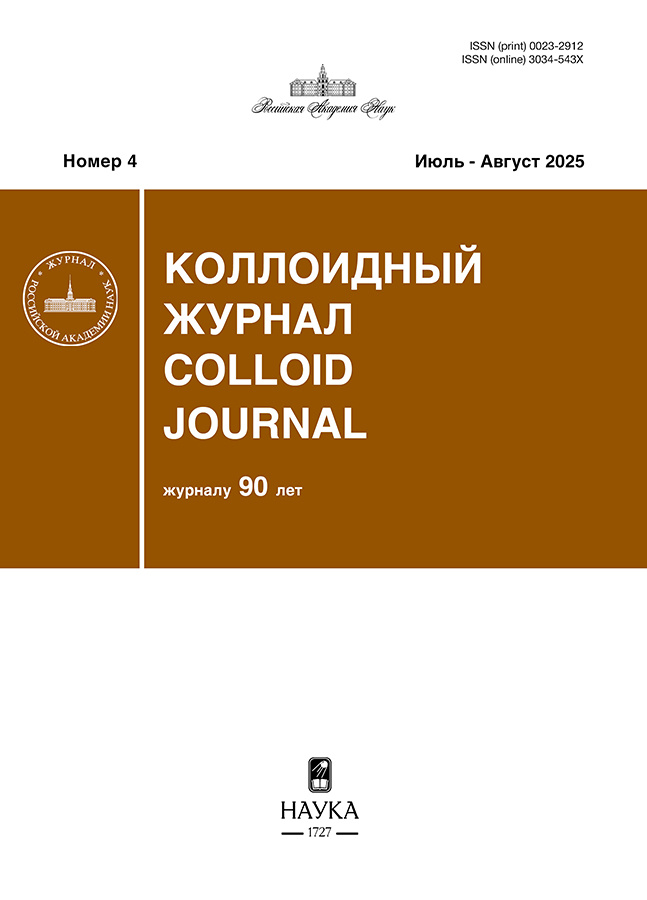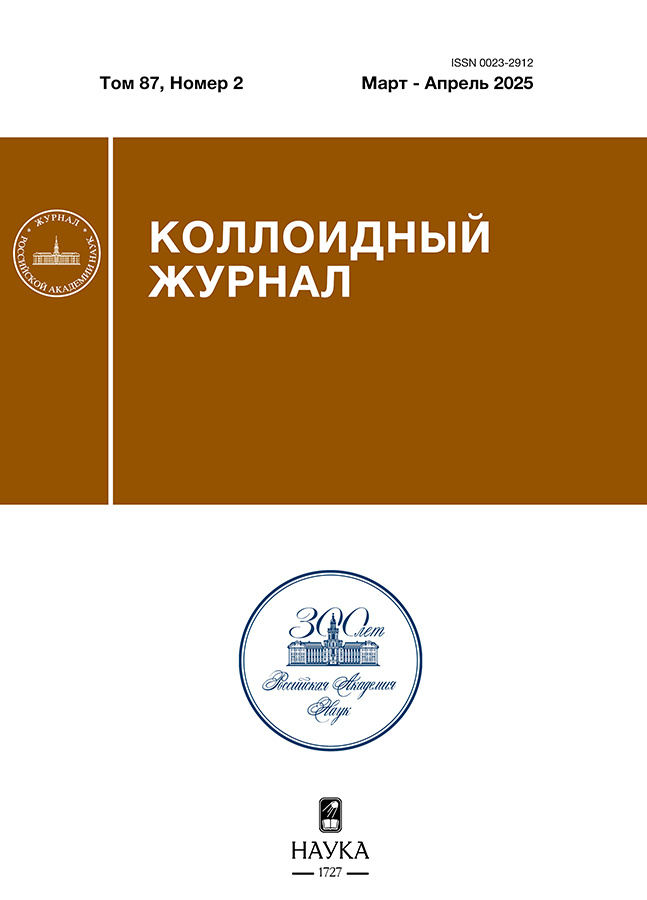Мицеллообразующие и антимикробные свойства серии бис-кватернизованных аммониевых соединений на основе производных дабко
- Авторы: Шайхутдинова З.М.1,2, Сапунова А.С.1, Салахиева Д.В.2, Паширова Т.Н.1, Волошина А.Д.1, Богданов А.В.1
-
Учреждения:
- Институт органической и физической химии им. А.Е. Арбузова, ФИЦ Казанский научный центр РАН
- Казанский (Приволжский) федеральный университет
- Выпуск: Том 87, № 2 (2025)
- Страницы: 161-170
- Раздел: Статьи
- Статья получена: 06.07.2025
- Статья одобрена: 06.07.2025
- Статья опубликована: 04.09.2025
- URL: https://journals.eco-vector.com/0023-2912/article/view/686822
- DOI: https://doi.org/10.31857/S0023291225020087
- EDN: https://elibrary.ru/tonlho
- ID: 686822
Цитировать
Полный текст
Аннотация
Комплексом методов (тензиометрия, кондуктометрия, динамическое рассеяние света, спектроскопия, флуориметрия) исследована самоорганизация длинноцепочечных бис-кватернизованных производных 1,4-диазабицикло[2.2.2]октана, содержащих гидроксиэтильную группу. Определены значения критической концентрации мицеллообразования, адсорбционные характеристики на поверхности раздела фаз воздух–вода, солюбилизационная емкость в отношении плохорастворимого в воде красителя ОранжОТ, числа агрегации и размеры ассоциатов. Установлено влияние структуры исследуемых соединений (длина алкильной цепи и заряд головной группы) на мицеллообразующие, антимикробные свойства и гемолитическую активность.
Полный текст
Об авторах
З. М. Шайхутдинова
Институт органической и физической химии им. А.Е. Арбузова, ФИЦ Казанский научный центр РАН; Казанский (Приволжский) федеральный университет
Email: tatyana_pashirova@mail.ru
Россия, Казань; Казань
А. С. Сапунова
Институт органической и физической химии им. А.Е. Арбузова, ФИЦ Казанский научный центр РАН
Email: tatyana_pashirova@mail.ru
Россия, Казань
Д. В. Салахиева
Казанский (Приволжский) федеральный университет
Email: tatyana_pashirova@mail.ru
Россия, Казань
Т. Н. Паширова
Институт органической и физической химии им. А.Е. Арбузова, ФИЦ Казанский научный центр РАН
Автор, ответственный за переписку.
Email: tatyana_pashirova@mail.ru
Россия, Казань
А. Д. Волошина
Институт органической и физической химии им. А.Е. Арбузова, ФИЦ Казанский научный центр РАН
Email: tatyana_pashirova@mail.ru
Россия, Казань
А. В. Богданов
Институт органической и физической химии им. А.Е. Арбузова, ФИЦ Казанский научный центр РАН
Email: tatyana_pashirova@mail.ru
Россия, Казань
Список литературы
- Obłąk E., Futoma-Kołoch B.,Wieczyńska A. Biological activity of quaternary ammonium salts and resistance of microorganisms to these compounds // World J. Microbiol. Biotechnol. 2021. V. 37. P. 22. https://doi.org/10.1007/s11274-020-02978-0
- Hu Y., Xing Y., Yue H. et al. Ionic liquids revolutionizing biomedicine: recent advances and emerging opportunities // Chem. Soc. Rev. 2023. v. 52. p. 7262–7293. https://doi.org/10.1039/D3CS00510K
- Saverina E.A., Frolov N.A., Kamanina O.A. et al. From antibacterial to antibiofilm targeting: An emerging paradigm shift in the development of quaternary ammonium compounds (QACs) // ACS Infect. Dis. 2023. v. 9. № 3. p. 394–422. https://doi.org/10.1021/acsinfecdis.2c00469
- Zakharova L.Y., Pashirova T.N., Doktorovova S. et al. Cationic surfactants: Self-assembly, structure-sctivity sorrelation and their biological applications // Int. J. Mol. Sci. 2019. v. 20. № 22. p. 5534. https://doi.org/10.3390/ijms20225534
- Frantz A.L. Chronic quaternary ammonium compound exposure during the COVID-19 pandemic and the impact on human health // Toxicol. Environ. Health Sci. 2023. V. 15. P. 199–206. https://doi.org/10.1007/s13530-023-00173-w
- Arnold W.A, Blum A., Branyan J. et al. Quaternary ammonium compounds: A chemical class of emerging concern // Environ. Sci. Technol. 2023. v. 57. № 20. p. 7645–7665. https://doi.org/10.1021/acs.est.2c08244
- Raj S., Ramamurthy K. Classification of surfactants and admixtures for producing stable aqueous foam // Adv. Colloid Interface Sci. 2024. V. 331. P. 103234. https://doi.org/10.1016/j.cis.2024.103234
- Bjerk T.R., Severino P., Jain S. et al. Biosurfactants: properties and applications in drug delivery, biotechnology and ecotoxicology // Bioengineering. 2021. v. 8. № 8. p. 115. https://doi.org/10.3390/bioengineering8080115
- Vavina A.V., Seitkalieva M.M., Strukova E.N. et al. Fatty acid-derived ionic liquids as soft and sustainable antimicrobial agents // J. Mol. Liq. 2024. v. 410. p. 125483. https://doi.org/10.1016/j.molliq.2024.125483
- Pashirova T.N., Shaikhutdinova Z.M., Mironov V.F. et al. Ammonium amphiphiles based on natural compounds: Design, synthesis, properties, and biomedical applications. A Review // Dokl. Chem. 2023. V. 509. p. 71–88. https://doi.org/10.1134/S0012500823700179
- Pernak J., Rzemieniecki T., Klejdysz T. et al. Conversion of quinine derivatives into biologically active ionic liquids: Advantages, multifunctionality, and perspectives // ACS Sustain. Chem. Eng. 2020. v. 8. № 25. p. 9263–9267. https://doi.org/10.1021/acssuschemeng.0c03501
- Bazina L., Maravić A., Krce L. et al. Discovery of novel quaternary ammonium compounds based on quinuclidine-3-ol as new potential antimicrobial candidates // Eur. J. Med. Chem. 2019. v. 163. p. 626–635. https://doi.org/10.1016/j.ejmech.2018.12.023
- Burilova E.A., Pashirova T.N., Lukashenko S.S. et al. Synthesis, biological evaluation and structure-activity relationships of self-assembled and solubilization properties of amphiphilic quaternary ammonium derivatives of quinuclidine // J. Mol. Liq. 2018. v. 272. p. 722–730. https://doi.org/10.1016/j.molliq.2018.10.008
- Pashirova T.N., Zhil’tsova E.P., Kashapov R.R. et al. Supramolecular systems based on 1-alkyl-4-aza-1-azoniabicyclo[2.2.2]octane bromides // Russ. Chem. Bull. 2010. V. 59. P. 1745–1752. https://doi.org/10.1007/s11172-010-0307-9
- Gilbert P., Al-taae A. Antimicrobial activity of some alkyltrimethylammonium bromides // Lett. Appl. Microbiol. 1985. V. 1. № 6. P. 101–104. https://doi.org/10.1111/j.1472-765X.1985.tb01498.x
- Lainioti G.C. Druvari D. Designing antibacterial-based quaternary ammonium coatings (surfaces) or films for biomedical applications: Recent advances // Int. J. Mol. Sci. 2024. V. 25. № 22. p. 12264. https://doi.org/10.3390/ijms252212264
- Dan W., Gao J., Qi X., et. al. Antibacterial quaternary ammonium agents: Chemical diversity and biological mechanism // Eur. J. Med. Chem. 2022. V. 243. p. 114765. https://doi.org/10.1016/j.ejmech.2022.114765
- Zhou C., Wang Y. Structure–activity relationship of cationic surfactants as antimicrobial agents // Curr. Opin. Colloid Interface Sci. 2020. V. 45. P. 28–43. https://doi.org/10.1016/j.cocis.2019.11.009
- Zhou C., Wang F., Chen H. et al. Selective antimicrobial activities and action mechanism of micelles self-assembled by cationic oligomeric surfactants // ACS Appl. Mater. Interfaces. 2016. V. 8. № 6. P. 4242–4249. https://doi.org/10.1021/acsami.5b12688
- Jennings J., Ašćerić D., Semeraro E.F. et al. Combinatorial screening of cationic lipidoids reveals how molecular conformation affects membrane-targeting antimicrobial cctivity // ACS Appl. Mater. Interfaces. 2023. V. 15. № 34. P. 40178–40190. https://doi.org/10.1021/acsami.3c05481
- Subedi Y.P., Alfindee M.N., Shrestha J.P. et al. Tuning the biological activity of cationic anthraquinone analogues specifically toward Staphylococcus aureus // Eur. J. Med. Chem. 2018. V. 157. P. 683–690. https://doi.org/10.1016/j.ejmech.2018.08.018
- Nadagouda M.N., Vijayasarathy P., Sin A. et al. Antimicrobial activity of quaternary ammonium salts: structure-activity relationship // Med. Chem. Res. 2022. V. 31. P. 1663–1678. https://doi.org/10.1007/s00044-022-02924-9
- Forman M.E., Jennings M.C., Wuest W.M. et al. Building a better quaternary ammonium compound (QAC): Branched tetracationic antiseptic amphiphiles // ChemMedChem. 2016. V. 11. № 13. P. 1401–1405. https://doi.org/10.1002/cmdc.201600176
- Kontos R.C., Schallenhammer S.A., Bentley B.S. et al. An Investigation into rigidity–activity relationships in BisQAC amphiphilic antiseptics // ChemMedChem. 2019. V. 14. № 1. P. 83–87. https://doi.org/10.1002/cmdc.201800622
- Frolov N.A., Fedoseeva K.A., Hansford K.A. et al. Novel phenyl‐based bis‐quaternary ammonium compounds as broad‐spectrum biocides // ChemMedChem. 2021. V. 16. № 19. P. 2954–2959. https://doi.org/10.1002/cmdc.202100284
- Thomas B., Duval R.E., Fontanay S. et al. Synthesis and antibacterial evaluation of bis‐thiazolium, bis‐imidazolium, and bis‐triazolium derivatives // ChemMedChem. 2019. V. 14. № 13. P. 1232–1237. https://doi.org/10.1002/cmdc.201900151
- Pashirova T.N., Zhil´tsova E.P., Lukashenko S.S. et al. Catalytic properties of polymer-colloid complexes based on polyethyleneimines and mono- and diquaternized 1,4-diazabicyclo[2.2.2]octane derivatives in the hydrolysis of phosphorus acids esters // Russ. Chem. Bull. 2015. V. 64. P. 2879–2884. https://doi.org/10.1007/s11172-015-1242-6
- Zhiltsova E.P, Lukashenko S.S., Pashirova T.N. et al. Self-assembling systems based on diquaternized derivatives of 1,4-diazabicyclo[2.2.2]octane // J. Mol. Liq. 2015. V. 210. P. 136–142. https://doi.org/10.1016/j.molliq.2015.01.018
- Pashirova T.N., Burilova E.A., Lukashenko S.S. et al. Nontoxic antimicrobial micellar systems based on mono- and dicationic Dabco-surfactants and furazolidone: Structure-solubilization properties relationships // J. Mol. Liq. 2019. V. 296. p. 112062. https://doi.org/10.1016/j.molliq.2019.112062
- Zakharova L.Y., Gaysin N.K., Gnezdilov O.I. et al. Micellization of alkylated 1.4-diazabicyclo[2.2.2]octane by nuclear magnetic resonance technique using pulsed gradient of static magnetic field // J. Mol. Liq. 2012. V. 167. P. 89–93. https://doi.org/10.1016/j.molliq.2011.12.015
- Voloshina A.D., Sapunova A.S., Kulik N.V. et al. Antimicrobial and cytotoxic effects of ammonium derivatives of diterpenoids steviol and isosteviol // Bioorg. Med. Chem. 2021. V. 32. p. 115974. https://doi.org/10.1016/j.bmc.2020.115974
- Rosen M.J., Kunjappu J.T. Surfactants and interfacial phenomena. John Wiley & Sons, Inc. 2012. https://doi.org/10.1002/9781118228920
- Song L.D., Rosen M.J. Surface properties, micellization, and premicellar aggregation of gemini surfactants with rigid and flexible spacers // Langmuir. 1996. V. 12. № 5. P. 1149–1153. https://doi.org/10.1021/la950508t
- Rosen M.J., Liu L. Surface activity and premicellar aggregation of some novel diquaternary gemini surfactants // J. Am. Oil Chem. Soc. 1996. V. 73. № 7. P. 885–890. https://doi.org/10.1007/BF02517990
- Tsubone K., Arakawa Y., Rosen M.J. Structural effects on surface and micellar properties of alkanediyl-α,ω-bis(sodium N-acyl-β-alaninate) gemini surfactants // J. Colloid Interface Sci. 2003. V. 262. № 2. P. 516–524. https://doi.org/10.1016/S0021-9797(03)00078-X
- Fisicaro E., Compari C., Biemmi M. et al. Unusual behavior of the aqueous solutions of gemini bispyridinium surfactants: apparent and partial molar enthalpies of the dimethanesulfonates // J. Phys. Chem. B. 2008. V. 112. № 39. P. 12312–12317. https://doi.org/10.1021/jp804271z
- Chauhan V., Singh S., Kaur T. Self-assembly and biophysical properties of gemini 3-alkyloxypyridinium amphiphiles with a hydroxyl-substituted spacer // Langmuir. 2015. V. 31. № 10. P. 2956–2966. https://doi.org/10.1021/la5045267
- Pashirova T.N., Sapunova A.S., Lukashenko S.S. et al. Synthesis, structure-activity relationship and biological evaluation of tetracationic gemini Dabco-surfactants for transdermal liposomal formulations // Int. J. Pharm. 2020. V. 575. p. 118953. https://doi.org/10.1016/j.ijpharm.2019.118953
- Lianos P., Zana R. Fluorescence probe studies of the effect of concentration on the state of aggregation of surfactants in aqueous solution // J. Colloid Interface Sci. 1981. V. 84. № 1. P. 100–107. https://doi.org/10.1016/0021-9797(81)90263-0
- Zana R., Binana-Limbele W., Kamenka N. et al. Ethyl(hydroxyethyl)cellulose-cationic surfactant interactions: electrical conductivity, self-diffusion and time-resolved fluorescence quenching investigations // J. Phys. Chem. 1992. V. 96. № 13. P. 5461–5465. https://doi.org/10.1021/j100192a050
- Danino D., Talmon Y., Zana R. Alkanediyl-.alpha.,.omega.-bis(dimethylalkylammonium bromide) surfactants (dimeric surfactants). 5. Aggregation and microstructure in aqueous solutions // Langmuir. 1995. V. 11. № 5. P. 1448–1456. https://doi.org/10.1021/la00005a008
- Araki M., Fujii S., Lee J.H. et al. Non-dependence of dodecamer structures on alkyl chain length in platonic micelles // Soft. Matter. 2019. V. 15. № 17. P. 3515–3519. https://doi.org/10.1039/C9SM00076C
- Fujii S., Yamada S., Matsumoto S. et al. Platonic micelles: Monodisperse micelles with discrete aggregation numbers corresponding to regular polyhedra // Sci. Rep. 2017. V. 7. p. 44494. https://doi.org/10.1038/srep44494
- Tishkova E.P., Fedorov S.B., Kudryavtseva L.A. et al. Antimicrobial activity and colloidal properties of N-alkyl-N-(2-oxyethyl)dimethylammonium halides // Pharm. Chem. J. 1989. V. 23. P. 418–422. https://doi.org/10.1007/BF00758296
- Balgavý P., Devínsky F. Cut-off effects in biological activities of surfactants // Adv. Colloid Interface Sci. 1996. V. 66. P. 23–63. https://doi.org/10.1016/0001-8686(96)00295-3
- Devínsky F., Kopecka-Leitmanová A., Šeršeň F. et al. Cut-off effect in antimicrobial activity and in membrane perturbation efficiency of the homologous series of N,N -dimethylalkylamine oxides // J. Pharm. Pharmacol. 1990. V. 42. № 11. P. 790–794. https://doi.org/10.1111/j.2042-7158.1990.tb07022.x
- Pashirova T.N., Lukashenko S.S., Zakharov S.V. et al. Self-assembling systems based on quaternized derivatives of 1,4-diazabicyclo[2.2.2]octane in nutrient broth as antimicrobial agents and carriers for hydrophobic drugs // Colloids Surf. B Biointerfaces. 2015. V. 127. P. 266–273. https://doi.org/10.1016/j.colsurfb.2015.01.044
- Zhiltsova E.P., Pashirova T.N., Kashapov R.R. et al. Alkylated 1,4-diazabicyclo[2.2.2]octanes: self-association, catalytic properties, and biological activity // Russ. Chem. Bull. 2012. V. 61. P. 113–120. https://doi.org/10.1007/s11172-012-0016-7
- Manaargadoo-Catin M., Ali-Cherif A., Pougnas J.-L. et al. Hemolysis by surfactants – A review // Adv. Colloid Interface Sci. 2016. V. 228. P. 1–16. https://doi.org/10.1016/j.cis.2015.10.011
- Gilbert P., Moore L.E. Cationic antiseptics: diversity of action under a common epithet // J. Appl. Microbiol. 2005. V. 99. № 4. P. 703–715. https://doi.org/10.1111/j.1365-2672.2005.02664.x
- Jones M.N. Surfactants in membrane solubilisation // Int. J. Pharm. 1999. V. 177. № 2. p. 137–159. https://doi.org/10.1016/S0378-5173(98)00345-7
Дополнительные файлы


















